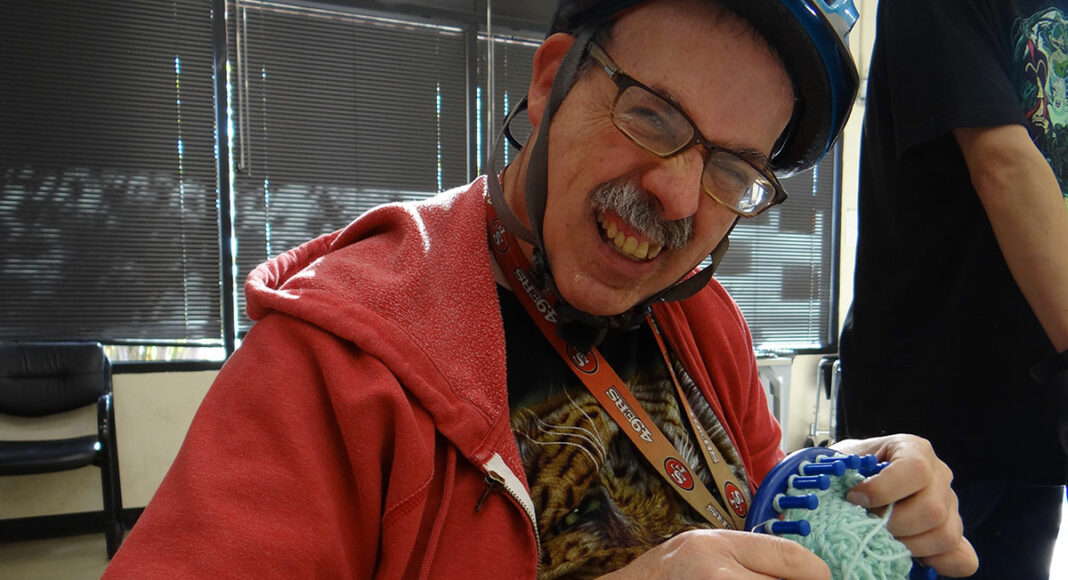Anyone suffering from Zoom-induced ennui in their work and personal life might benefit from a glimpse inside Hope Services’ Hope to Home program. The virtual classes serve more than 140 developmentally disabled clients in Santa Cruz and in neighboring areas.
For three-and-a-half hours every weekday, clients learn about things like Covid-19 safety. They practice knitting and other crafts. They tell jokes, make videos and have a good time. There’s even a regular dance party. If everyone approached Zoom with this degree of enthusiasm, the pandemic would be a lot easier to endure.
Hope Services is one of 40 nonprofits participating in the Santa Cruz Gives campaign, which raises money for charities during the holiday season. Hope’s mission is to improve quality of life for people with developmental disabilities and mental health needs, serving adults and teens in Santa Cruz County and neighboring areas. Donations benefit the Hope to Home program, the organization’s “Big Idea” for 2021. Funds will help equip 50 clients with laptops and tablets, and allow them to access live, interactive, daily online programming, providing a lifeline that allows this vulnerable population to continue learning and social interaction in trying times.
“Normally, we have a variety of programs for clients here at the Santa Cruz facility,” says Sheryl Hagemann, program manager in the Hope Services’ Santa Cruz office. “Now that we’re contending with the pandemic, none of our traditional day programs are able to function. So we had to devise another program to serve their needs. We started this effort after the first shelter-in-place and rolled it out on a larger scale in June. The level of response and participation has been amazing—not only in the Santa Cruz district, but in San Jose, Hollister, Half Moon Bay, and elsewhere in northern California.”
The three Hope to Home clients I spoke with via Zoom were all eager to express their enthusiasm for the program.
Toby Ames, 35, of Boulder Creek, has a developmental disability and has participated in Hope Services programs for 13 years. When I ask him about Hope to Home, he gets so excited that he quickly bounces out of the frame before returning an instant later.
“It’s really important to me,” he says of his daily Zoom meetings. “You know, we do a dance program every Friday.” With that, he busts out a few moves on screen, singing a tune from Justin Bieber’s “Under the Mistletoe” album.
He has also been telling jokes.
“Do you know the one about the cow crossing the road?” he asks. Answer: to get to the “udder side.” It’s one of his favorites, he says.
While employees around the country and the world are talking about “Zoom fatigue,” Ames has never even considered such a notion. For him, teleconferencing is a gift, not a chore. He’s also the Zoom expert in the group, helping others learn how to use the platform.
Greg Jones of Santa Cruz, 39, has been a Hope client for more than 30 years. He wears a floppy Santa hat and irrepressible grin. His favorite Hope to Home activity is playing bingo.
“Sometimes I win!” he exclaims. “The first day using an iPad was hard, but I’m getting the hang of it now. I can’t go out, and I don’t like that, but at least I can visit my friends on the iPad. It’s really important to me, and in some ways it’s easier.”
Amy Colendich, 30, of Santa Cruz, has participated in Hope Services programs for eight years. As part of the new Hope to Home program, she’s done art collages, made videos, and learned about Covid-19 best practices. Her next goal: learn sign language.
“In some ways, I like Zoom better,” she says of the change to Hope Service’s approach. “I really look forward to it.”
Hagemann, the Hope Services manager, says the Hope to Home program’s success has blown her away. It’s been a case study in people using their resilience and creativity to make the best of unexpected circumstances.
It hasn’t always been easy. The change to Zoom created a shift in programming style, the need for a different mindset and financial challenges. “It’s novel for us to use Zoom, so there has been a lot of staff training,” Hagemann says. “Clients face challenges, too; many don’t have access to an iPad, computer, or even home internet. Grants and community efforts like Santa Cruz Gives really help.”
Even after the pandemic subsides, Hagemann predicts the Hope to Home distance learning program will continue in some form.
While it isn’t for everyone, the webinar format fits with some personalities and learning styles, she explains.
Pandemic or not, Ames, the Zoom expert, will be ready. He says he won’t grow tired of showing others how to use iPads or how Zoom works. Maybe he can even demonstrate some new dance moves.
“I want to teach people,” he says.
Visit santacruzgives.org for information on how to donate to Hope Services or any of the other nonprofits participating in Santa Cruz Gives by Dec. 31.













